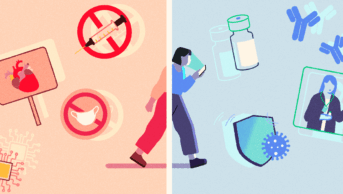Homelessness is a continuing social concern across the UK. In Glasgow there are an estimated 500 people sleeping rough on the streets at any one time[1]
. In England the number of people sleeping rough has risen consecutively for the past 6 years[2]
. The experience of homelessness includes not only sleeping on the streets, but also living in insecure or inappropriate housing. The experience of homelessness can be transient, or intermittent and recurring[3]
.
The evidence is strong that people who experience homelessness have higher morbidity and mortality rates and poorer outcomes from long-term conditions compared with the general population. There is also often more limited use of primary healthcare services, leading to an increased use of acute emergency secondary care services when in crisis[3]
.
A specialist homeless health service general practice team was set up in 2003 to help address these needs for people experiencing homelessness in Glasgow. This primary care-based practice consists of four sessional GPs, two rotating health inequality GP fellows, practice nurses, a healthcare assistant, and three sessional clinical pharmacists. The practice shares consulting rooms with other teams, including nursing, dietetics, podiatry, occupational therapy, mental health, sexual health, addiction services, and a dedicated homeless families team. Patients are able to attend with or without appointment. Outreach clinics are also held at local hostels, involving the GPs, pharmacists, healthcare assistant, and many of the different teams work with patients in their accommodation setting too.
The Pharmacist consults with patients in the practice or in the outreach clinics. Pharmacists routinely see four to six patients in a half-day clinic; consultations usually last 30–50 minutes.
The pharmacist offers patients a full health and medication check, and also monitor and prescribe for long-term conditions such as diabetes, chronic obstructive pulmonary disease and cardiovascular health. This can involve recording blood pressure, oxygen saturation, peak expiratory flow rate, spirometry, and sputum testing for microscopy, culture and sensitivity and tuberculosis screening. Blood tests are also taken by the pharmacist for testing blood-borne virus, HbA1c, renal function, and cholesterol. Current medicines are reviewed, checking adherence, appropriateness, and reconciliation from hospital or prison discharge. The patient’s local community pharmacist is often contacted, who provides a good source of support and feedback for the patient and the clinician.
Data was collected from a small sample of patients seen by pharmacists between August 2015 and August 2016 (124 patients across the year). Most (100 patients; 80%) seen were male, and the average age was 45. The most common prescribing intervention was the initiation of a new medicine for 53 patients (42.7%), followed by dosage changes to current medicines for 33 patients (26.6%). Ten patients (8%) had their current medicines stopped, the formulation of medicines changed in eight patients (6.5%), and the community pharmacist was consulted for clarification of medicines in 11 patients (8.9%).
This illustrates the positive confident use of the independent prescribing qualification by pharmacists in this setting, and the good opportunity these pharmacist clinics can provide to optimise medicines.
Consultations are patient centred, mindful of possible dropout and low engagement with healthcare. Every opportunity is used to build trust, and to show respect. Building a good therapeutic relationship is often the key to increasing engagement and improving outcomes for patients. To help build rapport in Glasgow, football is often discussed. Glasgow has two famous football teams, Celtic and Rangers, both of whom have a faithful following in the city. Both clubs have provided the pharmacists with free replica football strips and occasionally match tickets for distribution directly to patients on a one-to-one basis as appropriate, which is always well received. This helps improve trust and engagement by sharing and encouraging a social interest and finding common ground.
Future work is planned this year to enable pharmacists to conduct assertive street outreach, in collaboration with established voluntary sector street outreach workers in the city. Also in development is the setup of a process to identify and follow up patients recently discharged or self discharged from hospital.
Research is being undertaken, currently a systematic review of interventions for physical long-term health conditions by healthcare professionals to improve outcomes in homeless adults and shortly a qualitative study involving people who are homeless. This will seek to find out what service users currently think of pharmacist support and what developments would be welcome. The longer term plan is to conduct a subsequent feasibility study for a multicentre randomised controlled trial of collaborative engagement for long-term conditions in adults who are homeless.
Richard Lowrie
Lead Pharmacist, Research and Development
NHS Greater Glasgow and Clyde
Alison Hair
Pharmacist, Parkhead Health Centre
Pharmacist, Homelessness Health Service
Lauren Gibson
Pharmacist, Research and Development,
NHS Greater Glasgow and Clyde
Pharmacist, Homelessness Health Service, Glasgow
Acknowledgements: Andrea Williamson, GP homelessness health and clinical senior university teacher, Glasgow University Medical School; Ruth Spencer, lead GP homelessness and Izzie Gallacher, healthcare assistant, homelessness, both at Homeless Health and Resource Services, Glasgow; Nigel Hewett, medical director, Pathway Healthcare for homeless people, London.
References
[1] The Scottish Government. (2015) Homelessness in Scotland 2015-16. Available at: http://www.gov.scot/Resource/0050/00508824.pdf (accessed April 2017)
[2] Rough sleeping in England. Autumn 2016. Available at: https://www.gov.uk/government/statistics/rough-sleeping-in-england-autumn-2016 (accessed April 2017).
[3] Fazel S, Geddes JR & Kushel M. The health of homeless people in high income countries: descriptive epidemiology, health consequences, and clinical and policy recommendations. Lancet 2014;384:1529–1540. doi: 10.1016/S0140-6736(14)61132-6
You may also be interested in

Calling the shots: the pharmacists combatting vaccine misinformation

Embedding quality improvement in pharmacy practice: a departmental strategy at University Hospitals of Derby and Burton
